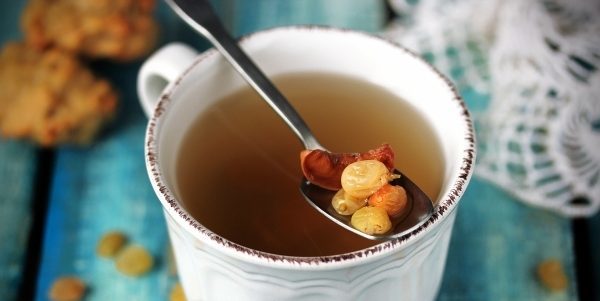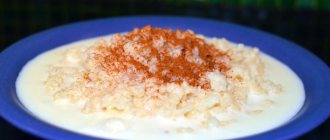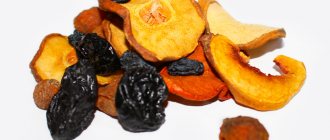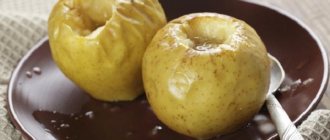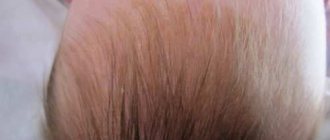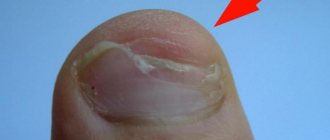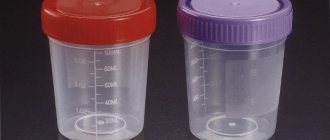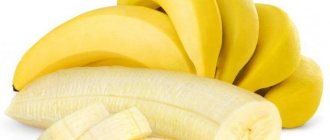The benefits and harms of dried fruit compote
Due to the large number of useful substances in dried fruits, compote from them also turns out to be extremely useful. And it's quite easy to prepare. However, it can harm a child’s body if it is made from low-quality raw materials. Among the beneficial properties of the drink it should be noted:
- high saturation of the body with vitamins, especially groups A and B;
- a huge amount of microelements in the drink: sodium, iron, potassium, calcium, phosphorus, magnesium;
- strengthening the immune system;
- normalization of the gastrointestinal tract, acceleration of metabolism;
- saturating the child’s body with energy and moisture (due to fructose content);
- restoration of fluid, mineral and salt balance in the body during intestinal disorders, poisoning and vomiting.
If fruits dried with chemicals, preservatives or other impurities were used to prepare the drink, the compote may turn out to be harmful to the child. And lead to the manifestation of allergic reactions, diseases of the gastrointestinal tract, and respiratory tract. However, an allergy can also occur as a result of consuming a decoction of high-quality dried fruits, to the type of fruit itself. So you should try compotes gradually, from each type separately.
Drink contraindications for children
Based on the high allergenicity of dried fruits, the main contraindication to drinking is individual intolerance to dried fruits. If it can be identified, then the fruit should simply be excluded from the diet in any form. If a child is diagnosed with poisoning or an intestinal disorder, then you should not give him prune compote. It has a laxative effect on the body, which can lead to dehydration.
Decoctions of fruits high in sugars (fructose, glucose, sucrose) are not recommended for diabetic children. First of all, figs, raisins, dried apricots, pears and bananas are prohibited. Also, dried fruit compotes are contraindicated for gastritis, pancreatitis and peptic ulcers.
Beneficial properties of dried fruit compote
How is dried fruit compote beneficial for babies? The drink with valuable nutritional qualities was appreciated by pediatricians, caring parents, and, of course, the kids themselves for its taste.
Dried fruits contain a maximum of useful substances - vitamins and microelements, which are practically not destroyed during drying and proper preparation.
The benefits of dried fruit compote for young children are as follows:
- The drink made from dried fruit contains a lot of vitamins, especially group B, and also contains large amounts of vitamin A;
- it is a storehouse of minerals: it contains sodium and iron, potassium and phosphorus, calcium and magnesium;
- perfectly strengthens the baby's immunity;
- normalizes the functioning of the digestive system; a prune drink for babies against constipation is one of the best and safest remedies;
- it is a source of additional fluid, especially in hot weather;
- fructose contained in dried fruits will add sweetness to the drink and give the baby a boost of energy;
- The drink is recommended for diarrhea and vomiting as a source that quickly restores the water balance in the baby’s body, and for saturation with minerals.
Note that multi-ingredient drinks made from fresh or dried fruits and berries are less beneficial for infants, and compotes made from exotic fruits should be completely excluded from the baby’s diet.
What to do if you are allergic to dried fruits
An allergic reaction to a drink can occur at any time. And manifest itself in the form of redness, rash, swelling, itching. The manifestations can be cured using different means: ointments, baths, powders. But neutralizing the cause is possible in only one way - eliminating the allergen. To make it easier to understand which fruit causes a pathogenic reaction, you should try them separately. And after identifying it, remove it from the diet.
If you cannot determine the allergen yourself, you will need to consult a doctor. He will take a blood test and be able to find out what type of dried fruit the reaction occurred to. All that remains is to follow his recommendations for a complete cure for the disease. As a rule, food allergy tendencies with proper nutrition go away by the age of 6 years.
How to properly cook dried fruit compote
Cooking dried fruit compote for babies is very simple. The raw materials are first soaked, then steamed and cooked. It is better to soak the fruit in the evening so that the drink is fresh in the morning.
How long to soak
Buckwheat porridge for babies - how to cook buckwheat at home
First you need to calculate the amount of raw materials and water. For every 10 g of product, take 100 ml of water. It turns out that for 50 g of prunes or apples, use 500 ml of water. For the first time, it is enough to boil 20 g of fruit, since the baby will only try the compote.
Dried fruits are brewed in water for at least 15 minutes. Pour the raw material with warm water in a deep bowl. Change the water several times until it becomes clear. It is important to thoroughly clean the product from dirt so that no dust, sand particles or husks remain. An infant should receive only fresh and high-quality drink.
After washing, soak the dried fruits in slightly warm water for 15-30 minutes until they swell. Dried fruits are again poured with fresh warm water and left to soak up the water. If you prepare the compote in the evening, you can soak it overnight.
How long to steam
They are boiled in the same water in which the dried fruits were soaked. Pour everything into a small saucepan. Add more water to make half a liter in total. Cover with a lid. It is advisable to use a container with a transparent lid so as not to open the pan again.
Place the dishes on the stove and turn on the highest heat. As soon as the water boils, reduce the heat and cook for 10 minutes. Leave for 1 hour for the compote to infuse. A cooled drink made from dry fruit is offered to the baby.
A glass lid is needed to preserve all the beneficial substances in the drink. The more often you open the lid of the saucepan, the more they evaporate. It is easier to observe the preparation of the drink through the glass lid. Then it must be left for 1-2 hours.
Important! Compote for the baby is prepared daily. It must be fresh. An old drink can cause poisoning and diarrhea.
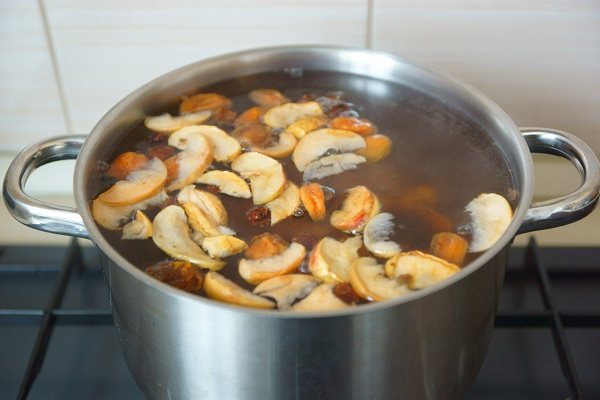
Compote in a pan
What can be combined with
You can combine dry fruits with each other for up to 12 months. A good recipe is to brew a compote of prunes and dried apricots for a child. Apples go well with any fruit. The older the baby, the more diverse components are added to the pan during cooking. It is important to remember that berries are allowed after a year, so it is better to cook such compotes for adult children.
What dried fruits can be introduced into complementary foods?
You can find out at what age you can give your child dried fruits from your pediatrician. As a rule, it is allowed to include them in the diet from 1 year, sometimes from 1.5 years. You can add dried fruits to cereals or purees as complementary foods starting from 6 months.
You should start with the safest fruits in terms of allergies: apples, pears, bananas. And it is dried (preferably naturally) fruits, and not candied fruits (candied or boiled in sugar syrup). Excessive sugar content can be harmful to the baby's health.
At one year of age, you can cook compotes from dried apricots and raisins. From one and a half years old - mix them into purees and porridge in crushed form. You must first soak the dried fruits in warm water to make them softer. Starting from the age of 2, a child can be given any fruit to try, but separately and in small quantities. Then it will be possible to recognize an allergic reaction in time (if it occurs), identify the allergen and begin treatment.
Benefits and composition of dried fruit compote
The beneficial properties of dried fruit compote are due to the variety of its ingredients. The drink perfectly quenches thirst and tastes good. Compotes are allowed for infants from 6 months of age. Benefit:
- Normalizes intestinal function.
- Increases children's immunity due to the high content of ascorbic acid.
- Accelerate metabolism, remove harmful substances from the body.
- They improve your mood due to the large amount of sugar in the composition.
- They remove excess fluid from the body and have a positive effect on the functioning of the cardiovascular system.
- Increases the level of hemoglobin in the blood - the composition contains a lot of iron.
- They stimulate brain activity and have a positive effect on memory development.
- They normalize liver function and help produce enzymes for digesting food.
- Enrich the body with useful microelements and vitamins.
Dried fruit compote is an indispensable product for a child. This is why doctors recommend introducing it at an early age. Thus, the baby’s gastrointestinal tract quickly gets used to digesting the components of fruits. Compotes are rich in useful minerals, these are:
- vitamin C;
- B vitamins;
- iron;
- zinc;
- magnesium;
- potassium;
- sodium.
The variety of composition of the drink depends on the components from which it is brewed.
At what age can you give compote to children?
Young mothers often wonder at what age to give their baby dried fruit compote. The nutrition of each baby should be organized individually, based on a whole set of indicators. Breastfeeding fully covers the baby's fluid and nutritional needs. But in some cases, including an additional source of vitamins is simply necessary.
Compote as an introduction to complementary foods
Of course, in the first 2-3 months you should not give the baby anything other than breast milk or formula. During this period, the child’s body is still adapting to the environment. From milk he gets everything he needs for growth and development. From 3 months, the inclusion of compote in the baby’s diet must be agreed with pediatricians. WHO does not recommend giving extra water to a child under 6 months unless there is a health reason. For example, problems with digestion or stool. After reaching six months, you can already cook compote from 1-2 types of dried fruits (preferably apples and/or pears), without sugar. And as you grow older, diversify your diet with other types of dried fruits.
Compote for night feedings
The rules are approximately the same as with complementary foods. Up to 6 months, a baby can wake up up to 4 times a night (this is normal). And it is better to feed him breast milk or formula, without additional liquids. And from the age of six months, you can completely wean your child off from night feedings. Naturally, this needs to be done gradually, reducing the number of waking ups. And here it is allowed to use compote from dried apples, pears or apricots. Closer to the year, the baby's diet will become so varied that he will no longer disturb his parents at night to replenish his strength. If this does not happen, you should consult your doctor. Perhaps sleep disturbance is due to other reasons (emotional overload in the evening, lack of walks, skipping daytime sleep, etc.).
At what age can you give it to a baby?
Dried fruits in their natural form are a complex food for a child. But compotes made from them are an excellent drink for infants and for a 1-year-old child. According to the World Health Organization, the best time to introduce complementary feeding to infants is 6 months of age. At this age, children's digestive system is sufficiently developed to accept new food.
In this case, complementary feeding must be accompanied by supplementary feeding to prevent constipation. If we talk about at what age a child can be given compote, then modern pediatrics recommends doing this no earlier than 6 months for breastfed children, for “artificially fed” children - 1-2 months earlier.
Individual recommendations regarding your child’s nutrition can be obtained from your local pediatrician.
How to properly introduce compote into a child’s diet
Before including dried fruit compote in your baby’s diet, you should consult your pediatrician. He will show you what to pay attention to and how to properly accustom your child to a new type of drink. The drink must be prepared from 1 type of dried fruit. And the baby should try it a little at a time, starting with 1 teaspoon (the portion should gradually increase). If an allergy appears after consumption, the fruit should be excluded from the diet.
Compote should be given after the child has eaten. This way, his appetite will not be lost, and food will be better absorbed thanks to the vitamins and microelements contained in dried fruits.
Recipe for dried fruit compote for infants
- Dried fruits of one type – 200 grams;
- Water – 1 liter;
- Sugar optional - one teaspoon.
Wash dried fruits, prepare for cooking and cut into slices. Pour into boiling water, cover the pan with a lid and place on low heat. Boil apples and pears for no more than half an hour, raisins, dried apricots or prunes - 15 minutes. At the end you can add a little sugar or fructose. Infuse the drink for 1-2 hours, cool to room temperature and give to the baby.
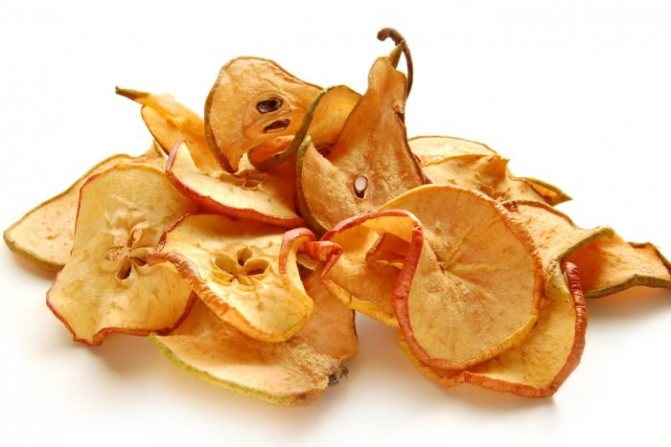
A drink made from dried fruits is also very useful for nursing mothers. A safe and hypoallergenic compote will improve mood and sleep, fill the body with vitamins and strengthen the immune system. In addition, it has a positive effect on lactation and stimulates the production of breast milk, relieves fatigue and stress. This is an excellent remedy for colds and flu.
Therefore, pediatricians recommend drinking natural drinks made from dried fruits while breastfeeding, especially if the nursing mother is sick, has problems with lactation, or is very tired. A recipe with a photo on how to cook dried fruit compote for nursing can be found at the link.
Subscribe to our VKontakte group
Selection of dried fruits for compote
For compote, you should select local fruits. Dried bananas, pineapples and oranges can be tried later. And in infancy it is better to limit yourself to “local” wealth.
Dried fruits must be ripe (at the time of collection and the start of drying), without external damage (cracks, holes, dimples). Also, you should not buy fruits with stains (this could be fungus or mold). Dried fruits that are too bright and soft should not be taken - most likely, chemicals or preservatives were used in their production. The fruit will need to be sorted before cooking. It is necessary to remove the stalks, twigs and leaves. The rest of the debris will be removed during the soaking process.
It should be remembered that as a result of heat treatment, dried fruits gain moisture and increase in size. Therefore, it is recommended to follow the proportions of the recipe: use 2 liters of water for 0.5 kg of fruit.
When to give dried fruit compote
How long to cook frozen broccoli for a child
From 4-6 months, babies are allowed to try sweet drinks. Preference is given to juices, as they contain more vitamins. But not all children want to drink them; in such cases they are offered compotes.
Raisin water
Raisin water for infants is allowed from 8-9 months. It causes increased gas formation. The drink is administered in small portions and the baby’s reaction is monitored. If there is no rash, constipation, or abdominal pain, then everything is fine. Raisins are dried grapes that make the drink sweet and rich. This compote is well accepted by babies. It is strictly prohibited for newborn children.
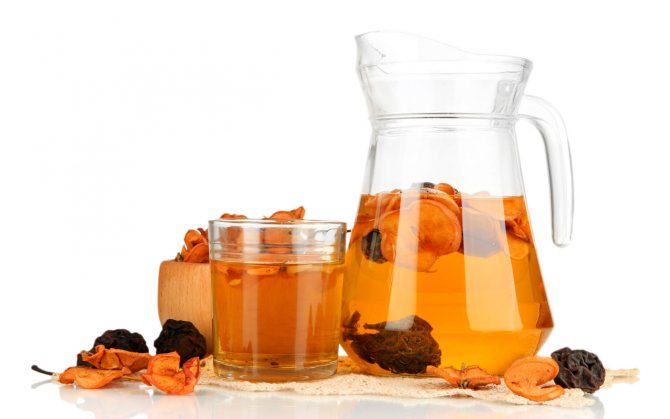
Dried fruits compote
Prunes
Prune compote is very healthy for babies. Since puree from this product is allowed to be administered at 4 months, the compote can be drunk almost immediately after administration. This dried fruit contains a huge amount of useful vitamins and microelements:
- potassium;
- calcium;
- magnesium;
- phosphorus;
- cobalt;
- iodine;
- zinc;
- fluorine;
- manganese;
- vitamins E, C, PP, group B.
If the baby already knows how to chew cookies, then you can offer him to suck on a dried plum. It tastes sweet, the baby will appreciate it. A decoction of prunes for babies helps with constipation; you should not add sugar to it. Just lightly steam the fruit and let it cool.
Important! If the baby often suffers from constipation, then this decoction is prescribed to him from 2-3 months, a couple of drops a day.
Apples
Apple is practically the first fruit that pediatricians recommend introducing your baby to. It is hypoallergenic, preference is given to green products. They improve digestion and eliminate constipation. Rarely, the drink causes gas formation and turns the stool green. After getting used to it, everything returns to normal. Apple compote for babies is allowed at 5-6 months. It is administered in small portions. It contains a large number of useful substances:
- folic acid;
- magnesium;
- sodium;
- iron;
- potassium;
- copper;
- phosphorus;
- biotin;
- B vitamins.
The main component of apples is pectin, which is a type of fiber. This compote perfectly quenches thirst. It tastes sweet due to the high glucose content in its composition.

In the arms of the mother, the child drinks from a cup
Dried apricots
Dried apricots are dried pitted apricots. Puree from this fruit can be introduced from 6 months. The only concern is an allergic reaction. Compote is introduced later than puree, for 1-2 months. No sugar is added. The child is allowed to try this drink from 8 months.
Dried apricots are rich in beneficial microelements and vitamins:
- calcium;
- magnesium;
- potassium;
- iron;
- vitamins A, B, C;
- a nicotinic acid.
The product contains 5 g of protein per 100 g. This is a large amount for a dried fruit. It is better to combine dried apricots with other dried fruits to get a good fortified and nutritious composition.
Important! Good quality dried apricots have a bright, rich orange color.
Quince
In appearance, quince resembles an apple and tastes like lemon. The compote made from it tastes sour, so it is better to combine dried fruit with other sweet products. It contains about 20 g of carbohydrates. For an adult this is a lot, but for a growing organism it’s the opposite. Carbohydrates provide energy for activity for babies. The composition includes a large number of useful vitamins and microelements:
- vitamins B, C, E, PP;
- potassium;
- sodium;
- Apple acid;
- lemon acid;
- pectins.
Quince contains a lot of potassium - 10 times more than other trace elements. Fruit compote improves the functioning of the heart, circulatory system, and lungs. Recommended for improving digestion.
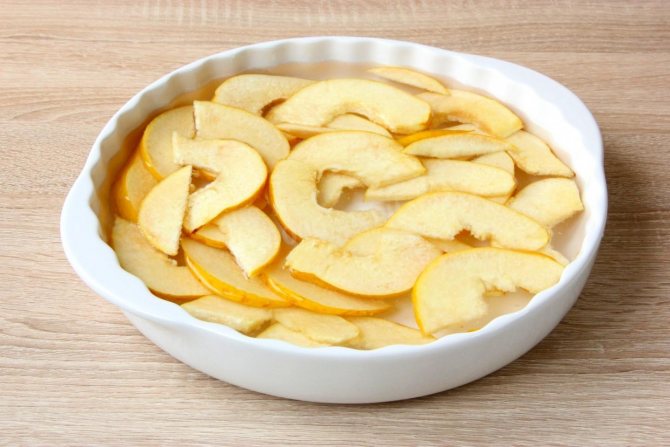
Quince compote
Other
You can also start getting acquainted with compotes with a pear. It is allowed to try it from 4-6 months, and cook compote from 7 months. It can be given for diarrhea, but for constipation it is better to abstain. Pear promotes gas formation and constipation. Therefore, it is allowed only if the baby does not have digestive problems.
Closer to the year, the baby will taste various berries, fruits and vegetables. His diet will become much more varied. Pediatricians allow adding a little sugar to the compote and brewing a drink from different products:
- peaches;
- pears;
- strawberries;
- cherries;
- cherries;
- strawberries;
- blueberries;
- blackberries.
This is not a complete list. Before introducing the compote, the baby is allowed to try fresh berries. If there is no reaction, then you can cook compote. Dr. Komarovsky shares the same opinion.
Important! Dried fruit compote is saturated with a large amount of vitamins necessary for infants.
How to cook compote for a child
The preparatory stage of cooking compote consists of soaking the fruits. They will need to be cut into 2-4 parts (depending on the size of the fruit), and then placed in warm water for 20 minutes. Prepared fruits must be placed in boiling water and simmered over low heat. The duration is determined depending on the type of dried fruit:
- apples and pears – 25-30 minutes;
- dried apricots and prunes – 15 minutes;
- raisins – 10 minutes.
Dried fruits can even be poured with boiling water and left overnight. By morning the compote will be ready. It is not recommended to add sugar, since dried fruits already contain a large amount of glucose. This makes the drink quite sweet. After turning off the stove, the drink should sit for about an hour. This time is necessary for its temperature to become equal to room temperature. Then the child will be more comfortable drinking it.
Recipe
To prepare the decoction, dried fruits should be soaked in warm water for about 15-20 minutes. This will make them softer and get rid of all the dirt stuck to them. The prepared fruits are filled with water and brought to a boil. They should boil for 5 minutes, no more. Then the stove must be turned off and the drink infused for about 2 hours.
For 0.5 liters of water you need to take approximately 50 g of dried fruits. Before giving the decoction to your child, you need to try it. If it turns out too tart or sweet, you can dilute it with boiled (filtered) water. Compote can be prepared in a thermos: add soaked fruit, pour boiling water and leave for 2 hours. After which the drink is ready to drink.
How to cook dried fruit compote
Every housewife knows how to cook compote correctly. However, preparing a drink for children has its own rules and characteristics, and the process of preparing a children's drink is somewhat different.
Let's look at how to cook dried fruit compote for a child under one year old, the basic rules and stages of preparation:
- use only high-quality dried fruits and in no case candied fruits (candied fruits);
- It is advisable to soak washed and dried fruits before cooking; this time ranges from 30 minutes to 2 hours until the fruits become soaked;
- Next, the water needs to be drained and the prepared fruits should be poured with boiling water;
- for cooking, use steel or enamel dishes without chips or cracks;
- boil the required volume of water and place dried fruits in a saucepan;
- maintain the correct proportions: 50 g of dried fruit requires at least 500 ml of water;
- Do not digest the compote for a long time, this will allow you to preserve the nutrients in it as much as possible. How long to cook: reduce the heat and cook the drink from apples or pears – 30 minutes; other dried fruits – 20 min. Raisin compote – 15 min.;
- let the drink brew after turning off the stove, closing it with a lid, for 30-60 minutes;
- Give your baby a drink cooled to a comfortable temperature and always strained.
- Don’t forget that the compote has a shelf life of 24 hours!
Can industrial drinks be used?
According to WHO recommendations, children should not be given industrially produced compotes until they reach the age of three. The manufacturing process usually uses preservatives, sugar and chemicals, and these are harmful to the health of babies.
If there is a need to introduce purchased drinks into your diet, then you should choose products from trusted manufacturers. The shelf life should be minimal, and the composition should include only natural ingredients. And yet, homemade compotes are safer for the baby’s health and more useful. Therefore, it is better to cook them yourself.
Dried fruit compote contains many vitamins and beneficial microelements. They can be given to children as complementary foods from 6 months. You just need to carefully monitor the child’s body’s reaction to one or another type of dried fruit in order to identify an allergy in time (if it manifests itself). And follow the dosages recommended by pediatricians.
The benefits and harms of dried fruits
Dried fruit compote: will such a drink be beneficial or harmful for a baby? If you prepare compote correctly without or with a minimum amount of sugar from high-quality dried fruits and use products to which your baby is not allergic, such a drink will only bring benefits. It performs a lot of useful functions:
- Saturates the body with vitamins and beneficial properties;
- Improves stool and digestive function, effectively helps with constipation;
- Strengthens the immune system and fights viral diseases;
- Gives vigor and strength;
- Regulates material metabolism;
- Gently cleanses the intestines and body, removes toxins and harmful elements;
- Helps with liver and kidney diseases;
- Replenishes iron deficiency.
Despite the benefits of compote, be careful about the choice of products and the cooking process. Remember that a baby may have a food allergy to some ingredients; excess sugar leads to weight gain, increased hemoglobin and provokes diabetes.
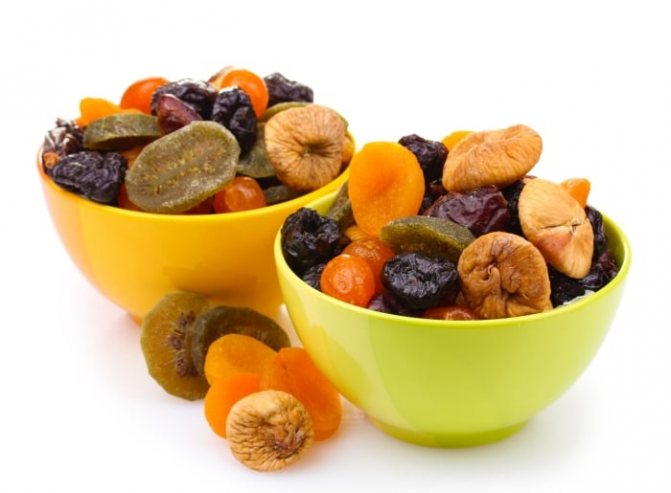
How to cook compote
To cook raisin compote for a child, take dried berries in the same proportion as for the decoction. The only difference will be the cooking time, since the compote takes longer to cook (up to an hour). It is not necessary to sweeten the compote, but if desired, you can add a little honey to it.
To diversify the taste, you can boil prunes, dried apples, black currant leaves and other ingredients along with raisins.
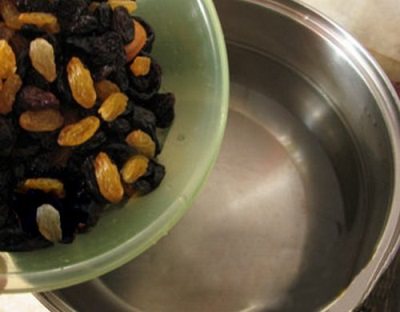
Prohibitions for dried fruit compote
Not all children are allowed to drink dried fruit compotes. If a child is allergic to fresh fruit, then compote made from dried fruit will be prohibited. Children prone to allergies are introduced to dried fruits with extreme caution. If a reaction occurs, then introduction to the healthy drink is postponed until after one year of age.
You should not drink pear compote if you have digestive problems. It tends to cause constipation and gas.
Compote of dried fruits for a child will perfectly complement the diet, saturate it with vitamins and useful minerals, and serve as an additional useful biological additive. Kids love compotes very much; they can be cooked tasty and sweet, and most importantly – healthy.
Plum for a child: from what age
You should start feeding your baby juicy fruits from 8–9 months: after introducing apples, bananas and the first vegetables into the diet.
By this period, the digestive system produces the necessary enzymes. If there is reason to doubt whether your child can eat plums or there are signs of food allergies, it is advisable to choose the yellow variety. It's less dangerous.

Complementary feeding begins with heat-treated juice or liquid puree. The washed fruits are boiled, preferably steamed, for 10 minutes. Then the skins are removed, the seeds are removed, and the pulp is rubbed through a sieve. If necessary, dilute with boiled water, formula, or mother's milk.
In the first days, children are given plums little by little: 0.5–1 tsp. after the main feeding. It is more useful to do this in the morning - it is easier to observe the reaction. If the baby’s health remains normal, the portion of puree is increased to 4–5 tsp.
Children can eat fresh fruits from the age of 1.5–2 years. Usually, by this age, babies are good at chewing, so crushing the fruits is not necessary. It is enough to remove the seeds from them. Large ones - cut into pieces. It is necessary to remove the peel from the fruit if the baby does not like its sour taste. However, you shouldn’t do this all the time so as not to lose most of the nutrients.
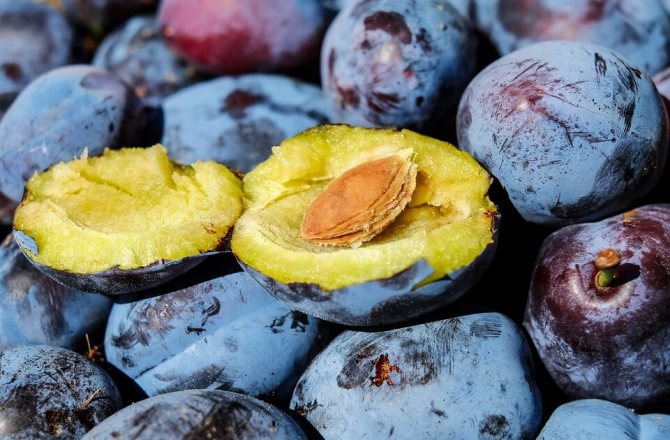
A child swallowed a plum pit, what should I do?
It is recommended that three-year-old children be taught to eat fruit on their own, showing how to properly remove excess fruit from it. If a child swallows a plum pit, there is no need to be afraid. To prevent its sharp edges from damaging the walls of the gastrointestinal tract, it is recommended to feed the baby with enveloping food: liquid oatmeal, jelly. Then monitor when the seed leaves the intestines naturally.
If you experience acute abdominal pain or blood in your stool, you should immediately go to the hospital.
At 2–3 years old, children can eat up to 5 plums at a time. At 4–5 years old - up to 10 pieces. It is not advisable to do this on an empty stomach or on a full stomach. The optimal time is between breakfast and lunch, during the afternoon snack. You can combine fresh plums with any fruit. Dried - with cottage cheese, porridge. Plum compotes, jelly, jam - use on their own, for dessert.

Fruits from local gardens are preferable to imported ones for children, as they are less likely to contain harmful chemical compounds. It is recommended to select fruits that are fully ripe, smooth, and without wrinkled areas, wormholes or spots. It is not advisable to offer overripe, too soft plums to children. It often provokes intestinal dysfunction.
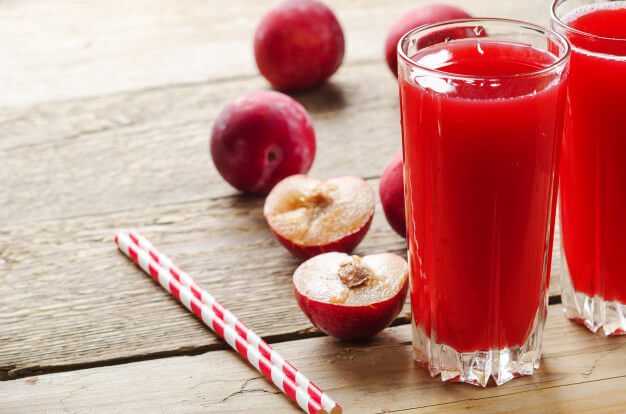
When can you introduce compote?
Before introducing compote into the baby’s diet, it is better for the mother to consult with a pediatrician. The optimal age is considered to be from three to eight months. It all depends on the child’s developmental characteristics, the functioning of his digestive system, his tendency to allergies, and other factors.
You need to give compote starting with one spoon, gradually increasing the amount. In case of poor tolerance, take a break. It is better to offer compote to your child after he has eaten, so as not to interrupt his appetite. The main thing is not to get too carried away, because the main source of liquid should still be mother's milk and water.
How to cook raisin compote with dried apricots for a child
For a baby over one year old, you can make multi-ingredient drinks, for example compote with raisins and dried apricots. Adults will also enjoy this sweet drink due to its taste and rich range of nutrients.
Ingredients:
- 200 grams of raisins;
- 200 grams of dried apricots;
- 3 liters of water;
- half a glass of sugar (optional).
Cooking time – 45 minutes.
The calorie content of dried fruit compote without sugar is 40 kcal.
The calorie content of a drink with sugar is 60 kcal.
Dried fruits must be washed thoroughly, add water and cook over medium heat until boiling.
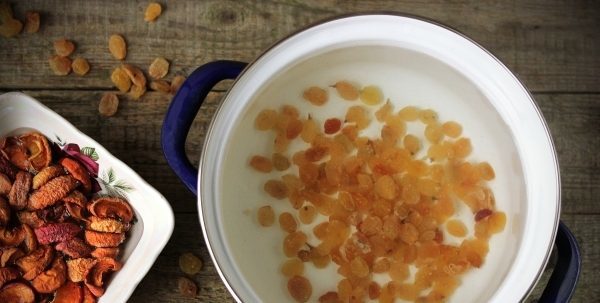
After the water boils, you can add sugar. Reduce the heat and cook for 20-30 minutes. Then the mixture needs to be cooled, then it will be even tastier.
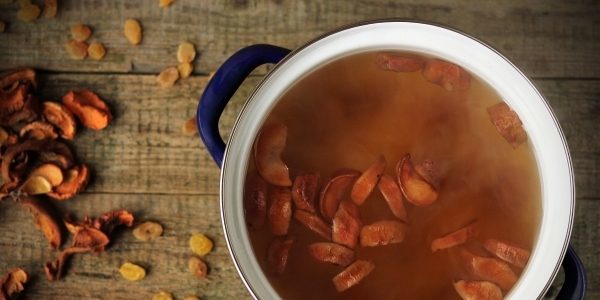
Instead of sugar, you can add honey to the drink, then the benefits will be even greater.
